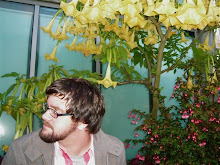 One of the reasons I usually enjoy living in Omaha is that I'm basically a small-town guy at heart. And let's face it, Omaha is kind of a small town. I want to think I'm a big city kind of guy; that I'm drawn to the largeness of movement and noise and action, but it's really not true. I travel for work several times a year, usually to larger cities, and after a few days, I usually can't wait to get back HOmaha. Even so, growing up in the midwest - first in Kansas, and for the last 10 years in Nebraska - I think I've had a tendency to take for granted the richness of the midwestern landscape. Who isn't at least a little drawn in by a soft breeze flowing over wheat fields before the harvest? Or the simple pattern of rows of corn, soybeans, and whatever else farmers grow around here?
One of the reasons I usually enjoy living in Omaha is that I'm basically a small-town guy at heart. And let's face it, Omaha is kind of a small town. I want to think I'm a big city kind of guy; that I'm drawn to the largeness of movement and noise and action, but it's really not true. I travel for work several times a year, usually to larger cities, and after a few days, I usually can't wait to get back HOmaha. Even so, growing up in the midwest - first in Kansas, and for the last 10 years in Nebraska - I think I've had a tendency to take for granted the richness of the midwestern landscape. Who isn't at least a little drawn in by a soft breeze flowing over wheat fields before the harvest? Or the simple pattern of rows of corn, soybeans, and whatever else farmers grow around here? The leaves started turning and falling in my Benson neighborhood several weeks ago. Initially they fell fast and hard, pulled down by the weight of a premature snow. Soon a wet, yellow blanket was covering the ground.
The leaves started turning and falling in my Benson neighborhood several weeks ago. Initially they fell fast and hard, pulled down by the weight of a premature snow. Soon a wet, yellow blanket was covering the ground. Over the course of the last few weeks bursts of rusty reds and oranges have joined the yellow blooms in a dying explosion of color. I don't remember the colors being this vibrant before. Or being so drawn to the contrasting tones. I'm nearly overtaken every time I turn a corner on my drive home from my studio. It gives me chills to see the yellow leaves flutter from the tops of the trees after small gusts of wind pull the stems from their branches. I don't remember being this influenced by nature either - maybe marriage is making me soft.

 These same past few weeks have been busy ones for me. I've been stealing as many hours in my shop as I can trying to turn these star fabrications into tables. They are also a simple gesture at both capturing and honoring the beauty of the Fall and coming Winter landscapes, respectively. The uniform shape of each piece - both in the star form and each contributing diamond shape - echoes the symmetry and simplicity of the fallen leaves. And like a leaf, the simplicity of their form sometimes masks a design that is more complicated the closer you look; it was not easy cutting and fabricating between 200 and 300 individual, uniform pieces of wood together. As I mentioned in my previous post, these pieces are my attempt to - dare I say - turn over a new leaf, in attempt to make work that is more environmentally sustainable than I've attempted in the past. I like to think that with each successive piece of furniture or art or whatever you'd like to call them, that I'm honoring the materials as much as I can.
These same past few weeks have been busy ones for me. I've been stealing as many hours in my shop as I can trying to turn these star fabrications into tables. They are also a simple gesture at both capturing and honoring the beauty of the Fall and coming Winter landscapes, respectively. The uniform shape of each piece - both in the star form and each contributing diamond shape - echoes the symmetry and simplicity of the fallen leaves. And like a leaf, the simplicity of their form sometimes masks a design that is more complicated the closer you look; it was not easy cutting and fabricating between 200 and 300 individual, uniform pieces of wood together. As I mentioned in my previous post, these pieces are my attempt to - dare I say - turn over a new leaf, in attempt to make work that is more environmentally sustainable than I've attempted in the past. I like to think that with each successive piece of furniture or art or whatever you'd like to call them, that I'm honoring the materials as much as I can.These tables are also part of my contribution to the ORGANISM project in the Empty Room. If you'd like to see how they turn out, please stop by ORGANISM throughout November and help us grow the space. Don't forget to bring your hammer.








